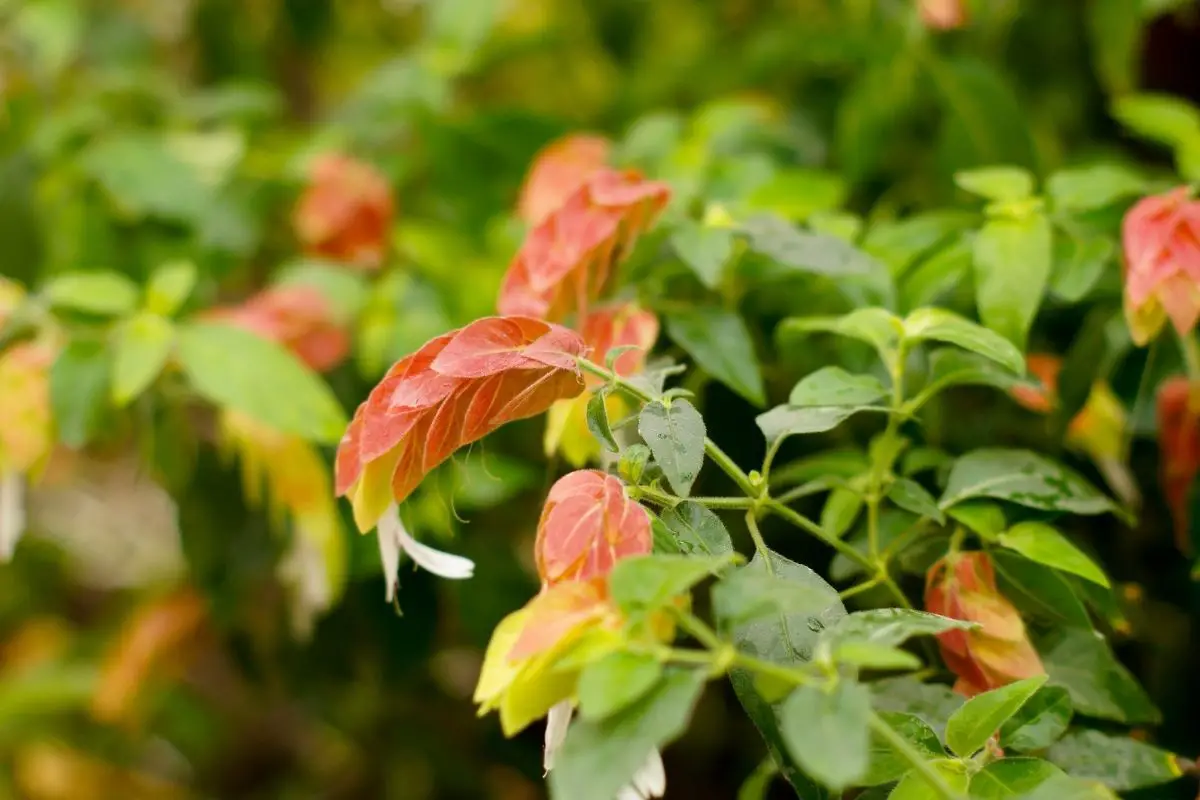Chuparosa, or Justicia californica is a species of flowering shrub with many recognized common names.
Native to California, Arizona, and Mexico, this plant commonly grows in deserts and attracts huge flocks of hummingbirds.
This perennial, also known as the hummingbird bush, is grown both as an ornamental plant for a desert garden and as a medium-sized shrub with a domed top.
History
The word chuparosa is the Spanish translation of the word hummingbird. The shrub is aptly named since flocks of hummingbirds hover over the bright red tubular flower heads.
Plant Facts
| Scientific name | Justicia californica |
| Common names | Beloperone, hummingbird bush, chuparosa, chiparosa |
| Genus | Justicia |
| Family | Acanthaceae |
| Height | 4 to 6 feet (1.83 m) |
| Width | 6 feet (1.83 m) |
| USDA Plant Hardiness Zone | Ones 8 to 9 (arid land only) |
| Native to | Deserts in California, Arizona, and Mexico |
| Blooming season | Most prolific in Spring |
| Flower colors | Red |
| Plant specific features | Nectar-rich blooms attract large flocks of hummingbirds |
How to Plant and Grow a Chuparosa Bush
Where to Plant
This plant is ideal to use in xeriscaping design. It makes a great accent shrub or background plant. It is ideal to use where you want to attain a natural look. You can plant a single plant, or use it in mass planting schemes.
And of course, it is perfect in a wildlife garden, due to the flocks of hummingbirds it will attract, particularly in Spring.
It will grow in poor soil and in coastal locations too. So it is a desert shrub that isn’t fussy and will provide color and interest with little attention.
When to Plant
Chuparosa is best planted in the fall or the spring. When planting, make sure you are not planting in wet or soggy soil.
Remember, this is a desert native shrub, that will survive during periods of drought although, without adequate water in the growing season, it will lose its leaves.
Chuparosa Shrubs Care and Maintenance
Soil
Chuparosa is tolerant of soil types. In its native growing environment, it grows in well-draining, sandy soil, typical of desert ground.
Water
Justicia californica is a plant that grows in the dry, arid land. It is native to deserts and therefore needs to be kept on the dry side. It’s really important not to over-water this shrub.
However, in periods of drought, and extreme heat, a lack of water will lead to the hummingbird bush losing its leaves. Give it some water, though, and the foliage will remain dense and succulent.
If you provide additional water in Spring, you are likely to have a chuparosa that flowers for longer and is a stronger, healthier shrub.
When watering the shrub, take care to ensure that the water can drain away freely. The hummingbird bush will not survive if it is left to sit in waterlogged soil.
Fertilizer
This hummingbird bush does not need feeding.
Sunlight
Chuparosa particularly likes a sunny location, so choose a site in full sun if possible. If you plant in partial shade, you will have fewer flowers on your shrub.
It’s a rough and tolerant shrub. Even if you plant the hummingbird bush against a wall that reflects the sun, it will thrive.
Pruning and Repotting
The belaprone (Justicia californica) doesn’t need pruning. If it has been neglected and insufficiently watered, then some trimming and shaping may be required.
Remove any dead branches, and shape them as required. You can easily keep the attractive mounded shape of this shrub with a little pruning.
J. californica has a naturally informal look. It can appear as a sprawling plant, but even with pruning, it is difficult to turn this shrub into a formal-looking plant.
Propagating
Hummingbird bush can be propagated from seed, or from softwood cuttings taken in the Spring.
It’s very easy to propagate chuparosa by cuttings. Although not necessary, the use of a hormone-rooting powder will speed up the process. Use a mixture of potting compost and sand in which to plant the cuttings.
Keep them in indirect sunlight until you notice some new top growth. This means that your cuttings have rooted and, at this point, you can plant them outside.
Pests and diseases
No pests or diseases are associated with J. californica.
Temperature and Humidity
This shrub has a tolerance to excessive heat and humidity. The warmer the temperature, the longer the flowering season will be If you are in a warmer region, your chuparosa will flower all winter.
J. californica is a semi-evergreen plant. If provided with supplementary watering, the shrub will retain its leaves throughout the year. However, it will lose its leaves during periods of heat and drought.
Other Uses for Chuparosa
The main use of this shrub is as an ornamental, easy-to-care-for, desert shrub. Its striking, lipstick-red flowers are stuffed with pollen, which is why they are a honey-pot for the hummingbirds.
Chuparosa flowers are edible, either in their raw state or cooked.
Types of Justicia californica You Can Grow
It’s the bright red flowers that make the chuparosa such a must-have desert shrub. It’s rare to find a red flowered shrub growing in arid regions.
Nevertheless, there are chuparosa which have yellow or orange blooms.
Conclusion
With its gray-green foliage and brilliant tubular flower heads, the chuparosa is a wonderful addition to a garden in any dry location.
What’s not to love about an evergreen that can flower most of the year, that will survive in full, even reflected sun, and require hardly any care!
Oh, and I forgot to mention that you will have flocks of hummingbirds feeding in your garden too!
*image by YAYImages/depositphotos

